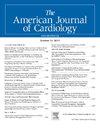经导管主动脉瓣置换术后主动脉瓣狭窄的不同血流梯度模式的结果和预测因素。
IF 2.3
3区 医学
Q2 CARDIAC & CARDIOVASCULAR SYSTEMS
引用次数: 0
摘要
本文章由计算机程序翻译,如有差异,请以英文原文为准。
Outcomes and Predictors of Different Flow-Gradient Patterns of Aortic Stenosis After Transcatheter Aortic Valve Replacement
This study sought to explore the clinical factors associated with classical low-flow low-gradient (C-LFLG) and normal-flow low-gradient (NFLG) aortic stenosis (AS) compared with high-gradient (HG) AS. We also compared clinical and echocardiographic outcomes after transcatheter aortic valve replacement (TAVR) across flow-gradient patterns. Patients with C-LFLG AS have a higher mortality rate after TAVR than those with HG AS. However, what leads to C-LFLG AS and the predictors of mortality in this population remain unclear. In this retrospective, single-center study involving 1,415 patients with severe AS, patients were classified as having (1) HG AS (aortic valve mean gradient [MG] >40 mm Hg), (2) C-LFLG AS (MG <40 mm Hg, stroke volume index <35 ml/m2, left ventricular ejection fraction <50%), and (3) NFLG AS (MG <40 mm Hg, stroke volume index ≥35 ml/m2, left ventricular ejection fraction ≥50%). Logistic regression was used for predictors of C-LFLG AS. Cox regression was used for predictors of mortality in the C-LFLG AS population. Male gender, multiple co-morbidities, and moderate to severe mitral and tricuspid regurgitation correlated with the C-LFLG AS group. Patients with C-LFLG AS had a higher mortality risk compared with patients with HG AS at 2 years after TAVR. Patients with NFLG AS had similar mortality at 1 year, but higher mortality at 2 years after TAVR compared with patients with HG AS. End-stage renal disease, atrial fibrillation, and other co-morbidities were predictors of 2-year mortality in patients with C-LFLG AS. In conclusion, the mortality rate after TAVR was higher among patients with C-LFLG AS than those with HG AS. Male gender and multiple co-morbidities were predictors of C-LFLG AS. Multiple co-morbidities were predictors of mortality among those patients.
求助全文
通过发布文献求助,成功后即可免费获取论文全文。
去求助
来源期刊

American Journal of Cardiology
医学-心血管系统
CiteScore
4.00
自引率
3.60%
发文量
698
审稿时长
33 days
期刊介绍:
Published 24 times a year, The American Journal of Cardiology® is an independent journal designed for cardiovascular disease specialists and internists with a subspecialty in cardiology throughout the world. AJC is an independent, scientific, peer-reviewed journal of original articles that focus on the practical, clinical approach to the diagnosis and treatment of cardiovascular disease. AJC has one of the fastest acceptance to publication times in Cardiology. Features report on systemic hypertension, methodology, drugs, pacing, arrhythmia, preventive cardiology, congestive heart failure, valvular heart disease, congenital heart disease, and cardiomyopathy. Also included are editorials, readers'' comments, and symposia.
 求助内容:
求助内容: 应助结果提醒方式:
应助结果提醒方式:


